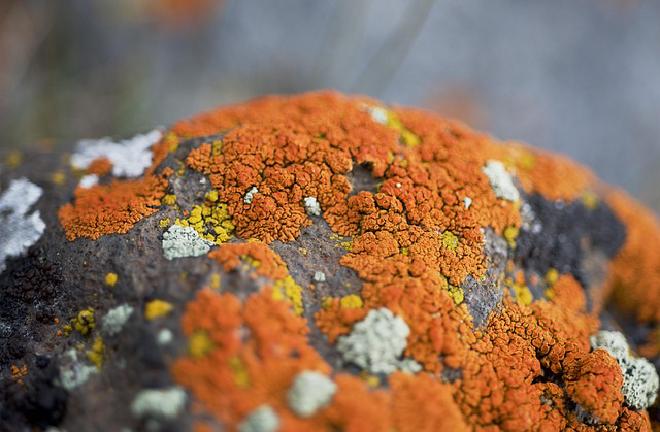

The findings, published in open access in the journal Nature Ecology & Evolution, came thanks to the use of a new methodology and sophisticated evolutionary models combining a variety of dating techniques.
The study is the product of international collaboration between multidisciplinary researchers from various countries and institutions, including the evolutionary biologist Eduard Ocaña, Ramon y Cajal researcher at the Universitat Oberta de Catalunya (UOC).
A new timeline for dating the origins of life #
Unlike plants or animals, which have left a rich and recognizable fossil record, fungi’s delicate and fibrous bodies are rarely preserved. Due to the limited number of fossils, their evolutionary history has so far been a puzzle full of missing pieces. To overcome this challenge, the researchers combined three different and complementary sources of information: the few fossils available, the genomic sequences of over a hundred species of fungi, and the effect of horizontal gene transfers, a key and innovative process that proved crucial in their endeavour.
These horizontal gene transfers are a rare but very important biological phenomenon whereby a gene crosses from one species to another. “When a gene jumps from one organism to another, that tells us that the two existed at the same time. This enables us to establish relative timelines, because any relative of the donor lineage must necessarily be older than any descendant of the lineage that received the gene,” said Ocaña. By using these chronological markers from horizontal gene transfer events, together with other techniques and new computational tools that reduce calculation times, the experts were able to obtain new, more accurate and reliable evolutionary timelines for over 100 species of fungi.
Fungi: terrestrial ecosystem pioneers #
Today’s fungi form symbiotic relationships with most plants, providing nutrients in exchange for carbohydrates. These relationships, known as mycorrhizae, may date back to very ancient times: millions of years ago, early fungi may have supported algae and early plants as they adapted to living on Earth in exchange for new sources of energy. “If we accept that fungi were instrumental in helping plants colonize the Earth, our theory is that this partnership may have started much earlier than previously thought, in environments similar to biological soil crusts or the microbial mats that we still have today,” said Ocaña, who works with the UOC eHealth Centre and the UOC-TECH Centre.
Rewriting the “empty Earth” narrative #
Fungi were therefore involved in establishing the earliest terrestrial ecosystems, a finding that would not have been possible without the international collaboration of scientists from a very wide range of backgrounds, including evolutionary biologists, palaeontologists, fungal experts and creators of new methodological tools. “The idea originated from an innovative tool developed by Dr Gergely J. Szöllősi’s Hungarian group, of which I was a member when I was doing my postdoctoral research. These findings wouldn’t have been possible without this collaboration or the contributions made by researchers from Hungary, England, Japan and Catalonia.”
New questions for the future #
This discovery also paves the way for new lines of research. The authors are now considering applying the same methodology to other major groups of eukaryotes to obtain a more accurate chronology of the entire course of evolutionary history. “Fungi were a great subject of study, because the scarcity of fossil records meant that our approach provided significant added value. The next challenge is to extend these techniques to all eukaryotes to develop a much finer molecular clock for all complex life,” said Ocaña.
Citation #
- The study A timetree of Fungi dated with fossils and horizontal gene transfers was published in Nature Ecology & Evolution Authors: Lénárd L. Szánthó, Zsolt Merényi, Philip Donoghue, Toni Gabaldón, László G. Nagy, Gergely J. Szöllősi & Eduard Ocaña-Pallarès
Acknowledgements #
J. Longcore is thanked for valuable discussions on the placement of the fossil Rhizophydites matryoshkae. The authors also thank the three reviewers for their contribution to the peer review of this work. We are grateful for the help and support provided by the Scientific Computing and Data Analysis section of Core Facilities at OIST. This project was supported by the János Bolyai Research Scholarship of the Hungarian Academy of Sciences to Z.M. (grant no. BO/00269/24/8). L.L.S., G.J.S. and E.O.-P. received funding from the European Research Council under the European Union’s Horizon 2020 research and innovation programme (grant agreement no. 714774). P.D. was funded by the Biotechnology and Biological Sciences Research Council (grant nos BB/T012773/1 and BB/Y003624/1), the Gordon and Betty Moore Foundation (grant no. 10.37807/GBMF9741), the Leverhulme Trust (grant nos. RF-2022-167 and RPG-2020-199) and the John Templeton Foundation (grant no. 62220; the opinions expressed in this publication are those of the author(s) and do not necessarily reflect the views of the John Templeton Foundation). T.G. acknowledges support from the Spanish Ministry of Science and Innovation (grant nos PID2021-126067NB-I00, CPP2021-008552, PCI2022-135066-2 and PDC2022-133266-I00), cofounded by ERDF ‘A way of making Europe’, as well as support from the Catalan Research Agency (AGAUR) (grant no. SGR01551), European Union’s Horizon 2020 research and innovation programme (grant no. ERC-2016-724173); Gordon and Betty Moore Foundation (grant number GBMF9742); ‘La Caixa’ foundation (grant no. LCF/PR/HR21/00737) and Instituto de Salud Carlos III (IMPACT grant nos. IMP/00019 and CIBERINFEC CB21/13/00061- ISCIII-SGEFI/ERDF). L.G.N. was supported by the National Research Development and Innovation Office (grant no. OTKA 142188) and the European Research Council (grant no. 101086900). E.O.-P. acknowledges support from FJC2021-046869-I funded by MCIN/AEI/10.13039/501100011033 and by European Union NextGenerationEU/PRTR, as well as from the Beatriu de Pinós programme (BP 2022, file number BP 00075). This work is part of the grant RYC2023-042807-I, funded by MICIU/AEI/10.13039/501100011033 and by the ESF+. The project that gave rise to these results received also the support of a fellowship from the La Caixa Foundation (ID 100010434). The fellowship code is ‘LCF/BQ/PI24/12040009’.
Contact [Notaspampeanas](mailto: notaspampeanas@gmail.com)

